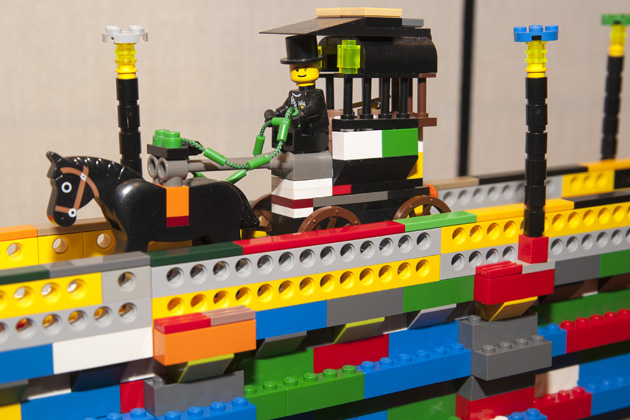
Gary Robbins, professor of geology in the Department of Natural Resources and the Environment, is an expert on hydrology. He’s involved with state-of-the-art groundwater research and teaching, and is a recognized expert on the fate and transport of groundwater contamination and groundwater supply sustainability. He also likes to play with LEGOs.
Robbins is the architect behind an exhibit of Roman aqueducts made from LEGOs on display in the Plaza Gallery of the Homer Babbidge Library until Oct. 24.

Among the featured models is the Aqua Claudia, built in the first century AD by Emperors Caligula and Claudius, that brought water to Rome from Subiaco, 45 miles away. It is considered possibly the finest of all Roman aqueducts, with some of its arches rising more than 100 feet high. Also represented are the Baths of Caracalla, the second largest of Rome’s public baths, built between AD 212 and AD 216, during the reign of the Emperor Caracalla.
“I love both the architecture and the engineering of the aqueducts,” Robbins says. “They are functional and beautiful at the same time.

“We take running water for granted,” he adds, “but were it not for Roman ingenuity, who knows how the world would have developed. As it was, with the aqueducts, they created a system that delivered running water and that led to indoor plumbing and sewer systems that helped control disease. Roman engineering was flawless, and they also managed to create fascinating architectural designs at the same time.”
But why LEGOs? To that question Robbins laughs and says, “You can credit my grandchildren for that. I have always liked to use online simulations as a teaching tool and I got the idea of creating three-dimensional computer simulations of aqueducts. But then I visited my grandchildren and saw the possibilities in their collection of LEGOs. That’s what got me started.”

For the uninitiated, ‘LEGO’ is an abbreviation of the two Danish words “leg godt”, meaning “play well”. Robbins notes that the colorful plastic pieces offer practically unlimited possibilities for creativity, and the fact that his grandchildren’s collection included tiny arches and columns that ‘spoke’ to him made it a natural leap for him to begin model building.
“These models are really good teaching tools,” he says, “but they’re also fun to build and to look at. There’s nothing wrong with making learning fun, and if my students smile while they’re learning about water transport, then so much the better.”
To see a model watermill in action, visit YouTube here.
A reception for exhibitors of this and other current exhibits at Babbidge Library will take place on Thursday, Aug. 28, from 5 to 6:30 p.m. in the Plaza Gallery. The exhibit will be on display through Oct. 24.



